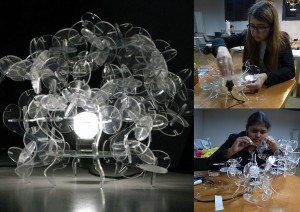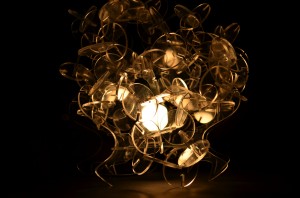LASER CUTTING: LAMP
The project of the lamp was an exercise to get familiar with the Laser cutter.The main particularity of the laser cutter as a fabrication technology is that it is exclusively used on sheet materials. Ours material is Methacrylate ribbing. Ribbing as a technique comprises quite an open range of possibilities.Our idea is founded on the reproduction of the same piece that fit with the other, equal to each other, its could multiply the light with the curved shape and dynamics . The base that holds the lamp and to which the pieces are hooked, it follows the same soft forms of the whole. The lamp was developed on the concept of “interlocking”, such that they can be dismantled and re-assembled according to user preference. A base module was created and each piece interlinked with it to bring out the desired form.






















